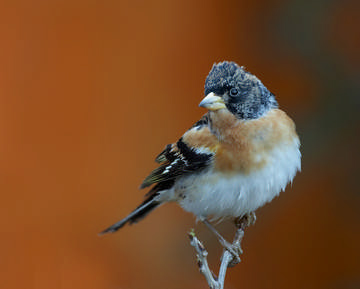Brambling (Fringilla montifringilla)

Brambling © Richard Steel
The winter distribution of Bramblings is dictated primarily by the availability of seeds (mast) of beech trees, and flocks leave their breeding grounds in northern Fennoscandia and Russia to roam across Europe in search of an abundant food supply. Their sharp-edged bill, stronger than that of their close relative the Chaffinch, is well adapted for cutting into beech mast (BTO Winter Atlas). After exhausting, or failing to find, supplies of beech nuts, some Bramblings move on to occupy a wider range of habitats including open fields and sewage works; observers for this Atlas recorded small numbers, from one to four birds, in gardens in 19 tetrads. Analysis of the Atlas habitat codes shows that most records (37%) were from farmland, of all types, with equal numbers of tetrads (29%) recording human sites and woodland, almost all broadleaved or mixed, and 4% in scrub. Bramblings were often found with Chaffinches, and several fieldworkers detected them in mixed flocks by their wheezy, buzzing call.
The Atlas map shows that Bramblings were thinly distributed across the county, being reported from 101 tetrads, with a clear concentration towards the north-east of Cheshire. The picture has obviously changed since Bell (1962) observed that ‘the records show that flocks are much more likely to be found in the west than the east of the county in most years’. It also seems that the timing of Bramblings’ arrival in the county has changed over the years. Coward & Oldham (1900) wrote that they were ‘seldom met with in Cheshire before January’ and Boyd (1951) said that, in mid-Cheshire, ‘they seldom arrive before November and it is often December before the first is seen’. In Bell’s (1962) experience, it was rare to find any in the east of Cheshire before the New Year. These comments do not accord with modern findings, with birds in the county typically from October to April.
Their year to year fluctuations in distribution and abundance are illustrated by figures for the three winters of this survey. They were reported from 37 tetrads in winter 2004/ 05; from 55 tetrads in 2005/ 06; and from 31 tetrads in 2006/ 07. All the 20th century Cheshire ornithologists commented on these variations in Brambling numbers, Coward & Oldham (1900) linking them with the severity of the season, birds being ‘fairly plentiful’ in hard winters, while Bell (1962) wrote that ‘in some years it is very scarce or even absent; in others large flocks are seen’.
According to records submitted to the annual county bird reports, it seems that fewer Bramblings have visited the county over the years. Flocks numbering thousands of birds used to be reported on average every other year, but the last four-figure count was in 1983/ 84. Flocks at Lyme Park of 250 in 1995/ 96 and c.300 in 1997/ 98 were the largest recorded during the 1990s, and from 1999 to 2004 only two flocks in three figures were reported. During this Atlas there were only two flocks of over 50 Bramblings recorded: 250 birds feeding on wildbird seed crops at Broxton (SJ45R/ SJ45W) in November/ December 2005, and 160 in mixed woodland at Cholmondeley (SJ55K) in January 2007.
Although communal roosts are a notable feature of this species’ behaviour, only one record of roosting Bramblings was reported during this Atlas, when a small flock of 10 joined Chaffinches at Aston (SJ57P) in winter 2005/06, in rhododendrons beneath mature mixed woodland.
Sponsored by Malcolm Calvert

